USAF’s NTS-3 Vanguard is now closer to a 2023 launch
The Department of the Air Force’s Navigation Technology Satellite-3, or NTS-3, Vanguard program has reached another major milestone in preparation for the satellite’s launch in late 2023.
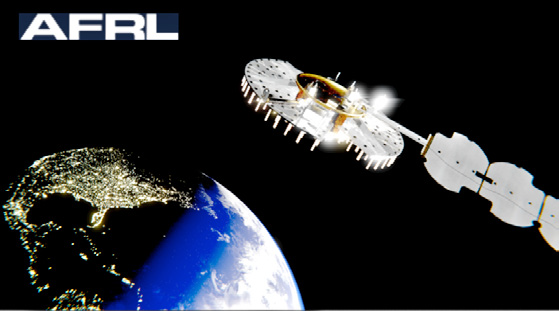
Industry partner L3Harris Technologies, the spacecraft prime contractor, recently delivered the NTS-3 space vehicle to an Air Force Research Laboratory (AFRL), integration and test facility at Kirtland Air Force Base, New Mexico.
The satellite integrates an agile positioning, navigation and timing, or PNT, payload to the Northrop Grumman ESPAStar bus, to provide a space platform for AFRL and partner organization experiments and integrated capability demonstrations.
In 2019, the U.S. Department of the Air Force designated NTS-3 as one of the first three Vanguard programs to deliver innovative, game-changing capabilities to the warfighter at an accelerated pace.
NTS-3, which is managed by the AFRL Transformational Capabilities Office and has program partners in both the U.S. Space Force and U.S. Air Force, will push the boundary of PNT technology to pave the way for a more flexible, robust and resilient architecture for satellite navigation.
AFRL and L3Harris are now completing the remaining intra-payload and payload-to-bus
functional and performance tests, including the first radio frequency broadcast tests of the novel PNT signals that will be demonstrated from near-geosynchronous orbit after the NTS-3 launch.

Artistic rendition of the NTS-3 space vehicle, based on the
Northrop Grumman ESPAStar satellite bus, is courtesy of
L3Harris Technologies.
The Global Navigation Satellite System Test Architecture, or GNSSTA, developed by the MITRE Corporation in partnership with the AFRL Sensors Directorate, is crucial for meeting end-to-end, NTS-3 mission objectives.
GNSSTA is a reprogrammable, software-defined receiver that allows users to receive legacy GPS and advanced signals generated by NTS-3 and lays the groundwork for future operational receivers to provide the Space Force with options to prevent and respond quickly to common threats on the battlefield, such as GPS jamming and spoofing.
NTS-3 is the first U.S. experiment of its kind in nearly 50 years, since the Navy Research Laboratory’s NTS-1 and NTS-2 spacecraft led the way for the Global Positioning System (GPS), constellation in the 1970s.
“This major milestone marks the transition from space system development at contractor’s facilities to the final stage of integration and test activities,” said Arlen Biersgreen, program manager, Navigation Technology Satellite-3.
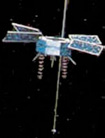
Artistic rendition of
the NTS-1 satellite.
Biersgreen continued, “The AFRL team will be overseeing and working closely with L3Harris and other key industry partners to apply an effective combination of contractor and government resources to successfully complete this phase of the effort. This Vanguard not only aims to support GPS users through vital development of new technologies and techniques, but also to show how an agile and responsive U.S. satellite navigation architecture is paramount to defeating the most challenging threats to warfighter success, both today and through the coming decades.”
Biersgreen said following those activities, the team will perform standard space environment tests that simulate the launch and space environments to verify the system is ready for the rigors of experimental operations in space. He added that experimental performance data from ground testing will be available for sharing with program partners during the next several months.
Dr. Joanna Hinks, the NTS-3 principal investigator, has worked closely with the Sensors team on the GNSSTA development and testing. “The entire team is excited that earlier this month, we successfully generated signals on the actual spacecraft and received them with our experimental GNSSTA user equipment,” Hinks said. “Showing the space segment and user segment working together like that is an important step to being ready to conduct experiments on-orbit.”
The Air Force Research Laboratory, or AFRL, is the primary scientific research and development center for the Department of the Air Force. AFRL plays an integral role in leading the discovery, development and integration of affordable warfighting technologies for our air, space and cyberspace force. With a workforce of more than 11,500 across nine technology areas and 40 other operations across the globe, AFRL provides a diverse portfolio of science and technology ranging from fundamental to advanced research and technology development.
ITAR isolators and circulators in L-, S- and X-band for MILCOM + radar applications
Smiths Interconnect has announced the availability of additional engineering and manufacturing capabilities in the U.S. for the company’s broad range of isolator and circulator components in -L, S- and X-Band.
Smiths Interconnect has been producing qualified isolators and circulators for over 20 years from its facility in Dundee, Scotland (UK).
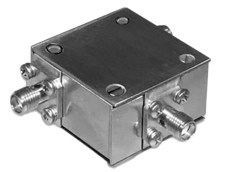
Now the company’s comprehensive range of high-power isolators and circulators for AESA radar applications, ground-based air surveillance radars, shipboard defense and airborne fire control is also available from the manufacturing site in Salisbury, Maryland, U.S.
These products are designed, manufactured, and tested to serve U.S. customers’ requests that are subject to ITAR (International Traffic in Arms Regulations) and DFAR (Defense Federal Acquisition Regulation)regulations.
These high-power series of isolators and circulators are designed for phase and temperature stability, phase matching, and robust performance in a multitude of defence environments.
They can be configured with a variety of connector/interface configurations, and can be fitted with value added components, couplers, detectors and filters to name a few. The units are tested and verified using Smiths Interconnect’s comprehensive in- house facilities.
“The addition of leading-edge capabilities to our Salisbury site allows us to serve our customersin the US that our site in Dundee could not serve effectively for a variety of ITAR and export control reasons. This aligns with our
reputation for excellence and our aspiration to be the partner of choice for cutting-edge connectivity solutions”, said Tullio Panarello, VP and
General Manager of the Fiber Optics and RF Components Business Unit at the company.
Smiths Interconnect’s isolators and circulators in L-, S- and X-band offer the following features:
◊ U.S ITAR and DFAR compliance
◊ Optimized electrical performance
◊ Qualification for Solid State Power Amplifiers (SSPA)
Northrop Grumman to modernize + advance the AFRL’s intelligence information gathering process
Northrop Grumman Corporation (NYSE: NOC) has been awarded a $406 million contract from the Air Force Research Laboratory Information Directorate (AFRL/ RI) for the Intelligence Systems Infrastructure, Tools and

Enhancements (InSITE) program to advance information collection and analysis across its customer set.
InSITE will modernize the AFRL/RI’s intelligence information collection, sharing and analysis capabilities by implementing state-of-the-art, artificial intelligence (AI) solutions. This will enable warfighters to make faster, better-informed decisions to deny, disrupt or defeat threats across all domains and with our global allies.
Grumman will provide cloud-enabled applications to foster data exchanges across U.S. Department of Defense and Intelligence Community customer centers and satellite locations, including the U.S. Space Force’s recently established National Space Intelligence Center in support of “One AFRL, Two Services.”
“Our innovative solutions will meet today’s advancing threats at unprecedented speed and accuracy, transforming decision- making and analysis,” said Rebecca Torzone, vice president and general manager, combat systems and mission readiness, Northrop Grumman. “Building on our 40 years of support to the AFRL/ RI, Northrop Grumman will digitally transform InSITE to meet its space domain awareness and counterspace intelligence mission priorities.”
The Spanish Ministry of Defence contracts Indra for Spanish airspace surveillance + control centers
The Spanish Ministry of Defence has awarded Indra a project to modernize and upgrade the nation’s command, surveillance, identification and control (ARS) centers that are essential for combating potential threats to the country’s airspace.
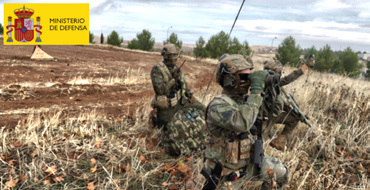
Indra will equip the ARS centers in Torrejón de Ardoz in Madrid (GRUCEMAC), Zaragoza (GRUNOMAC) and Gando in Gran Canaria (GRUALERCON) and the Command and Control School (EMACOT) with the company’s next- generation AirDef air command and control system, which will contribute to the mission for the permanent surveillance and control of airspace national sovereignty led by the Spanish Air and Space Force.
With this project, the Ministry of Defence will rely on Indra’s proprietary development solutions, as it did in the late 1990s with the IARS system that is currently in service at the above named centers. This system, together with the Lanza 3D radars in the Air Surveillance Squadrons (EVAs), forms the backbone of airspace surveillance and control in Spain.
Thanks to the modernization of the ARS centers with the new AirDef system, which incorporates anti-missile defence for the first time, and the new and more advanced Lanza 3D radars that Indra will continue to deploy, Spain’s status as a country with one of the most comprehensive and integrated air and anti-missile defence systems in the world and a global leader in this sphere will be reinforced.
AirDef, which is already operational in several countries around the world, has been designed to meet NAT O’s demanding air command and control requirements to facilitate its contribution to the Alliance’s Integrated Air and Missile Defence System (NATINAMDS), ensuring its essential and ongoing mission during times of peace, crises and conflicts to safeguard and protect the Alliance’s territory, populations and forces against any air or ballistic missile threat or attack.
Meeting these requirements and positioning itself with one of the most advanced command and control systems in operation in NATO countries opens up the possibility of other nations adopting Indra’s technology in keeping with the decision of the Spanish Ministry of Defence.
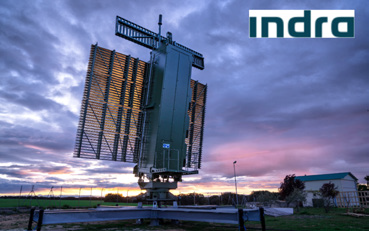
Indra’s system incorporates the latest software and hardware technologies and architectures, which enhance sensor fusion, recognized air picture generation (RAP) and real-time air and anti-missile battle management, providing operators with multiple smart decision-making aids through advanced, geo-positioned and configurable graphical interfaces.
The above will be possible thanks to the native integration of the most advanced NATO tactical data links (Link 16, JREAP, Link 22 and VMF) between the operating entities, guaranteeing their interoperability with those that have been in service in recent decades (Link 1, Link 11B and Link 11A), which are also integrated into Indra’s solution.
The implementation of the AirDef system at the Air Operations Center (AOC) of the Operational Aerospace Command (MOA) in Torrejón de Ardoz will also provide BMD (Ballistic Missile Defence) capabilities to manage the anti-missile defence, thanks to its
integration into Indra’s Lanza 3D LRR and LTR-25 sensors (similarly equipped with such capabilities) and the tactical data links with the anti-missile weapon systems. The AirDef system will also provide the Air Operations Center with a NATO-interoperable tool to generate the ATOs (Air Tasking Orders) and ACOs (Airspace Control Orders) required for the planning of air operations.
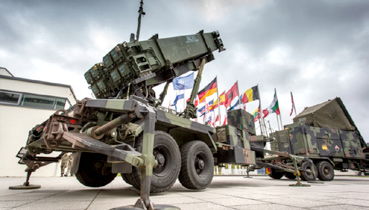
The project also envisions the implementation of a voice over IP communication system and remote control of the state-of-the-art ground/air radios known as GAREX-300M at the ARS centers. This system guarantees maximum resilience and availability and introduces new architectures to permit security clearance for the separate management of classified and non-classified (red/black) information between operators and between aircraft and centers.
This new system is currently being deployed at NATO’s Combined Air Operations Center (CAOC) in Uedem (Germany) with the aim of facilitating the coordination of the Alliance’s air policing missions throughout European airspace north of the Alps, thus demonstrating its ability to facilitate air operations of the utmost complexity.
The project is complemented by the provision of a software maintenance center, key to the concept of autonomous logistic support for the air command and control system units. The above constitutes a replica of the software and hardware architectures and it will facilitate security clearance maintenance, configuration control, the generation of new software packages, the execution of the different tests and the updating of the IETP manuals (Interactive Electronic Technical Publications).
In addition to further strengthening Spain’s air defenses and placing it at the forefront of the field, this project will reinforce Indra’s position as one of the most advanced defense-geared technological engineering companies in Europe and the world and a leader of the sector’s digitalization.
 NATO Combined Air Operations Centre a Uedem (left) + Combined Air Operations Centre Torrejón (right)
NATO Combined Air Operations Centre a Uedem (left) + Combined Air Operations Centre Torrejón (right)
Its state-of-the-art solutions for Land, Sea, Air, Space and Cyberspace range from operations with end-to-end defence systems and systems on board the most advanced platforms to training with cutting-edge simulation systems.
As an expert in radar, electronic defence, command and control and communication technologies, Indra incorporates artificial intelligence, big data, virtual reality and combat clouds in its cutting-edge critical systems.
Indra is the national industrial coordinator in Spain of the FCAS, the largest and most advanced defence program in Europe, and the Spanish company that coordinates the largest number of projects in the European defence sector.
Indra also participates in a large number of European and international projects, such as Eurofighter and the A400M. The company exports its radars to five continents and is the principal supplier to NATO.
“We’re proud to be able to use our technology to keep on helping to strengthen the security of our country and placing it at the cutting edge in the world. Indra’s collaboration with the Ministry of Defence and the Spanish Air and Space Force over several decades is a story of shared successes that have gone beyond our borders, as we’re sure will happen with AirDef, a system with 100% Spanish technology and excellent export potential, as we’ve already proven,” said Indra CEO, Ignacio Mataix.
www.indracompany.com
Seven nations meet to address space security
The Department of Defense participated in the annual Combined Space Operations (CSpO) Initiative Principals Board hosted by the New Zealand Defense Force and New Zealand Ministry of Defensein December of last year.
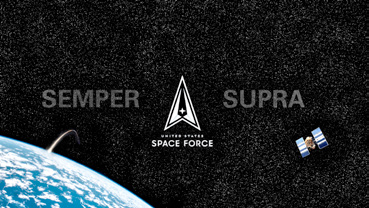
The annual event brought together counterparts from Australia, Canada, France, Germany, New Zealand, the United Kingdom, and the United States, with a focus on advancing collaboration and information sharing on space security topics.
CSpO is an initiative that seeks to generate and improve cooperation, coordination, and interoperability opportunities to sustain freedom of action in space, optimize resources, enhance mission assurance and resilience, and deter conflict.
During this year’s event, defense leaders emphasized the need to continue to promote a rules-based international order and responsible behaviors in space, while collaboratively addressing challenges to the safety and security of space-related operations.

Participants from the U.S. included Dr. John Plumb, Assistant Secretary of Defense for Space Policy; U.S. Space Force Gen. Chance Saltzman, Chief of Space Operations; U.S. Army Gen. James Dickinson, Commander, United States Space Command; and Mr. Damon Wells, National Reconnaissance Office (NRO).

The CSpO Principals Board last met in December 2021 in the United States, reaffirming support to prevent conflicts extending to or originating in space and to hold accountable those who threaten the safety of the space environment.
In February of this year, the group released the “CSpO Vision 2031,” outlining the initiative’s overarching purpose and highlights its guiding principles, including: freedom of use of space, responsible and sustainable use of space, partnering while recognizing sovereignty, and upholding international law.
These guiding principles steer the initiative’s objectives and are supported by several lines of effort, from developing and operating resilient, interoperable architectures to fostering responsible military behaviors in space and sharing intelligence and information, all leading to the pursuit of a safe, secure, and sustainable space domain.

